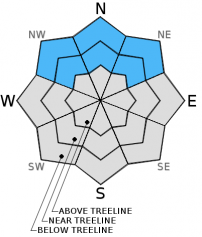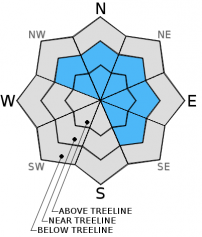| Sunday | Sunday Night | Monday | |
|---|---|---|---|
| Weather: | Mostly sunny | Clear | Sunny |
| Temperatures: | 10-19 deg. F. | 2-8 deg. F. | 22-27 deg. F. |
| Mid Slope Winds: | Variable in the morning shifting to the East in the afternoon | East | East |
| Wind Speed: | 10 mph increasing to 10-15 mph in the afternoon | 10-20 mph with gusts to 30 mph | 15-20 mph with gusts to 35 mph decreasing to 10-15 mph in the afternoon |
| Expected snowfall: | 0 | 0 | 0 |
| Sunday | Sunday Night | Monday | |
|---|---|---|---|
| Weather: | Mostly sunny | Clear | Sunny |
| Temperatures: | 8-15 deg. F. | 5-10 deg. F. | 22-27 deg. F. |
| Ridge Top Winds: | Northwest shifting to the Northeast in the afternoon | Northeast | Northeast shifting to the East in the afternoon |
| Wind Speed: | 15-25 mph with gusts to 40 mph | 20-35 mph with gusts to 55 mph | 20-35 mph with gusts to 60 mph decreasing to 15-25 mph with gusts to 40 mph in the afternoon |
| Expected snowfall: | 0 | 0 | 0 |


























